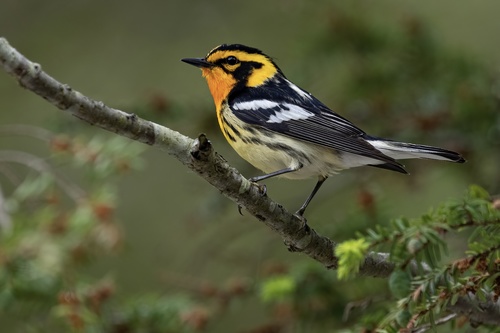
Blackburnian Warbler
The Blackburnian Warbler (Setophaga fusca) is a small, vibrant songbird renowned for its striking breeding plumage, particularly the male's fiery orange throat and face. It plays a crucial ecological role as an insectivore, helping to control populations of forest insects. This species is a long-distance migrant, undertaking impressive journeys between its breeding grounds in North America and its wintering grounds in South America. While not holding specific cultural significance like some larger birds, its beauty makes it a favorite among birdwatchers.
11-13 cm
Length
19-22 cm
Wingspan
Least Concern
Conservation Status
Distribution
Breeds across eastern North America, from southeastern Canada (Manitoba to Nova Scotia) south through the Appalachian Mountains to northern Georgia. Winters primarily in the Andes Mountains of South America, from Colombia and Venezuela to Peru and Bolivia.
Lifespan
Typically 3-5 years in the wild; maximum recorded lifespan is over 8 years.
Blackburnian Warbler's Habitat
Habitat Types
Mature coniferous forests, Mixed coniferous-deciduous forests, Spruce-fir forests
Climate Zones
Temperate, Boreal
Adaptations
Prefers dense, tall trees, showing an adaptation for foraging in the upper canopy. Their agility allows them to navigate complex branch structures.
Variations
No recognized subspecies.
Appearance
Breeding Plumage
Breeding males have a bright orange throat, face, and upper breast, with black streaks on the back and flanks, and white wing bars. Females and non-breeding males are duller, with yellowish throat and face markings. Non-breeding birds retain some of the pattern but with less intense coloration.
Seasonal Feather Changes
Significant seasonal variation; breeding plumage is much brighter than the duller non-breeding plumage.
Sex Based Plumage Differences
Pronounced sexual dimorphism, especially during breeding season.
Notable Features
Fiery orange throat and face (breeding males), Bold black and white wing bars, Dark, triangular ear patch
Diet and Feeding
Primary Foods
Insects, Spiders, Caterpillars, Beetles
Foraging Behavior
Primarily gleans insects from foliage in the upper canopy. Often hangs upside down to reach insects on the undersides of leaves and branches. May also hover briefly to catch flying insects.
Specializations
Their fine bill is well-suited for picking small insects from leaves and crevices.
Seasonal Diet Variations
Diet is almost exclusively insects during the breeding season. May consume some berries and fruits during migration and in wintering areas.
Behavior
Social Structure
Generally solitary or in pairs during the breeding season. May form small flocks during migration and on wintering grounds.
Communication
High-pitched, thin songs, Chip notes for contact calls, Two main song types, one more complex than the other
Migration
Long-distance migrant. Travels thousands of kilometers between breeding and wintering grounds, often flying at night.
Territorial or Group Behaviors
Males are highly territorial during the breeding season, defending their nesting and foraging areas from other males.
Conservation
Threats
Habitat loss (both breeding and wintering grounds), Climate change (affecting forest composition and insect availability), Collisions with buildings and windows during migration
Protection Programs
Sustainable forestry practices, Habitat conservation initiatives in the Andes
Local National Laws
Protected under the Migratory Bird Treaty Act in the United States and Canada.
Population Trend
Stable
Population Estimates
Global population estimated at around 19 million individuals.
Interesting Facts
Blackburnian Warblers are one of the highest-nesting warblers in eastern North America.
Their nests are often placed very high in coniferous trees, making them difficult to observe.
They undertake one of the longest migrations of any North American wood-warbler.
Their journey takes them from Canada and the US to the Andes Mountains of South America.
The species name 'fusca' means 'dark' or 'dusky' in Latin.
This likely refers to the dark back and crown of the male, contrasting with the bright orange throat.
Faqs about Blackburnian Warbler
What is the best way to attract Blackburnian Warblers to my yard?
Blackburnian Warblers are primarily forest birds and are unlikely to visit typical backyard feeders. However, maintaining mature trees, especially conifers, and avoiding pesticide use can help provide suitable habitat.
How can I tell a male Blackburnian Warbler from a female?
Male Blackburnian Warblers have a bright orange throat and face, while females have a yellowish throat and face. The male's black markings are also more intense.
Are Blackburnian Warblers endangered?
No, Blackburnian Warblers are currently classified as Least Concern by the IUCN. However, like many migratory birds, they face threats from habitat loss and climate change.
Copyright @ Nature Style Limited. All Rights Reserved.
 English
English